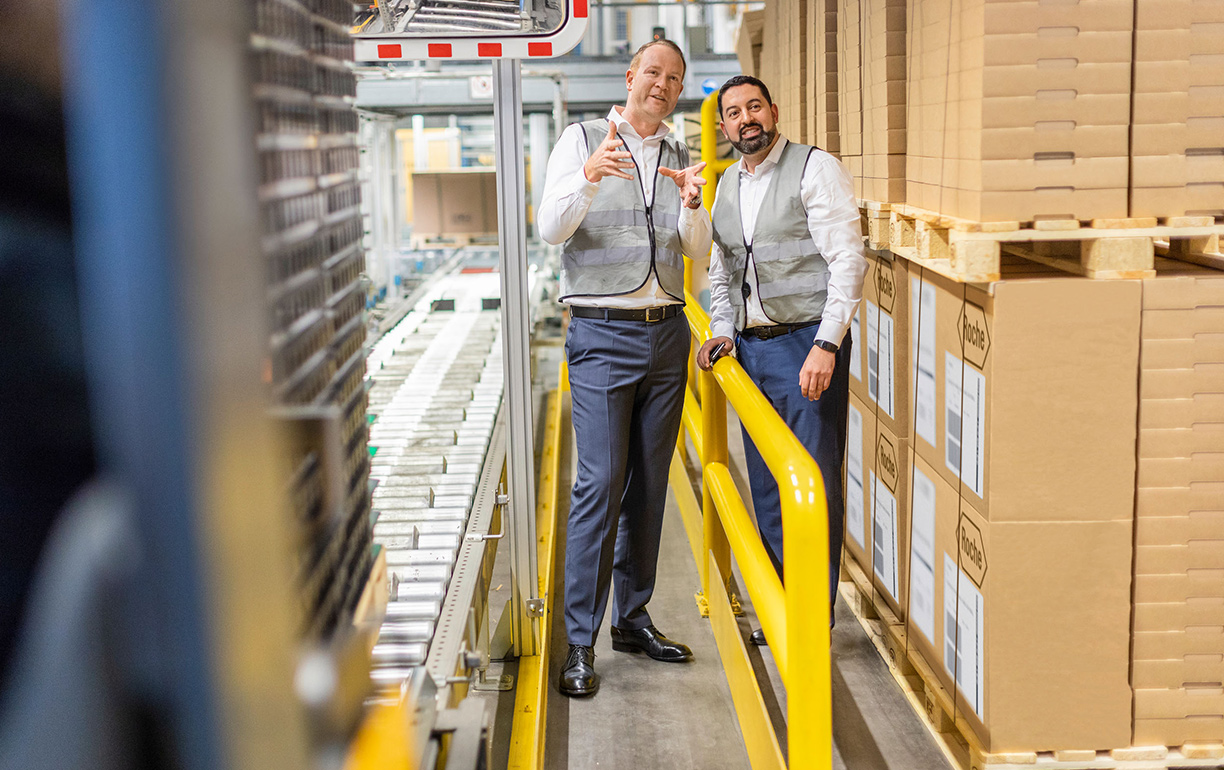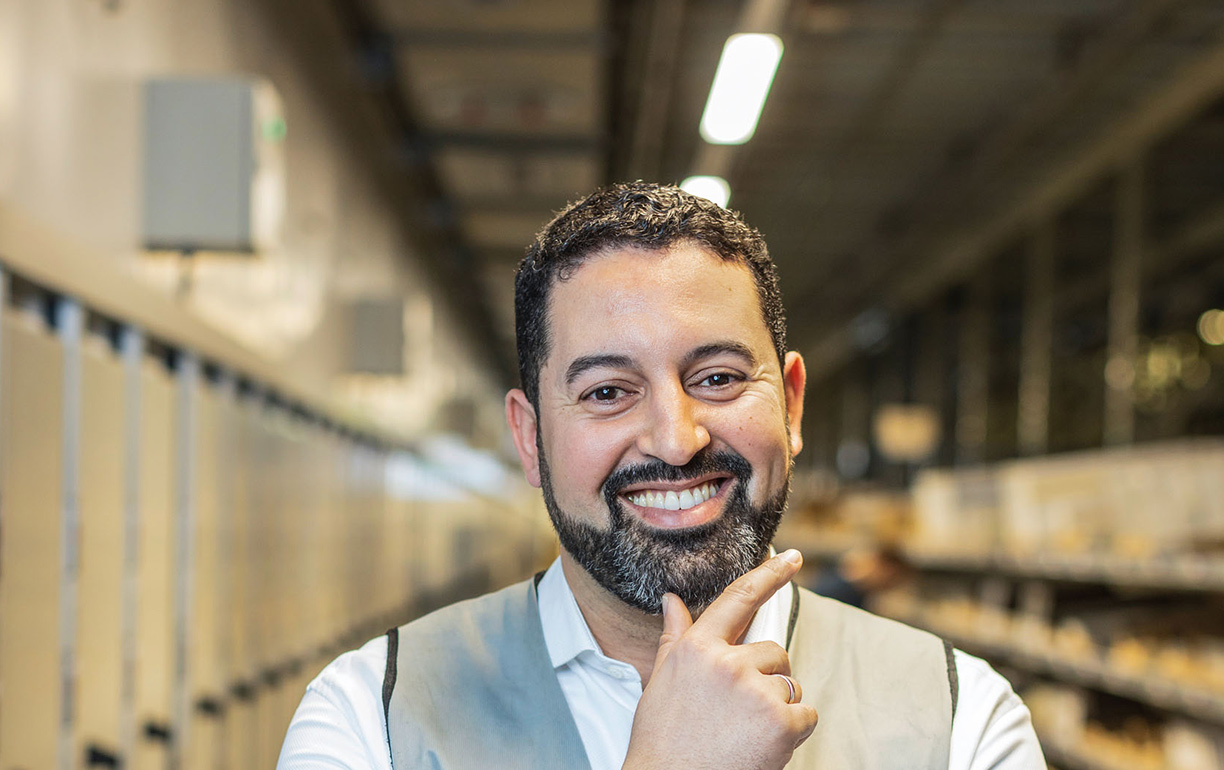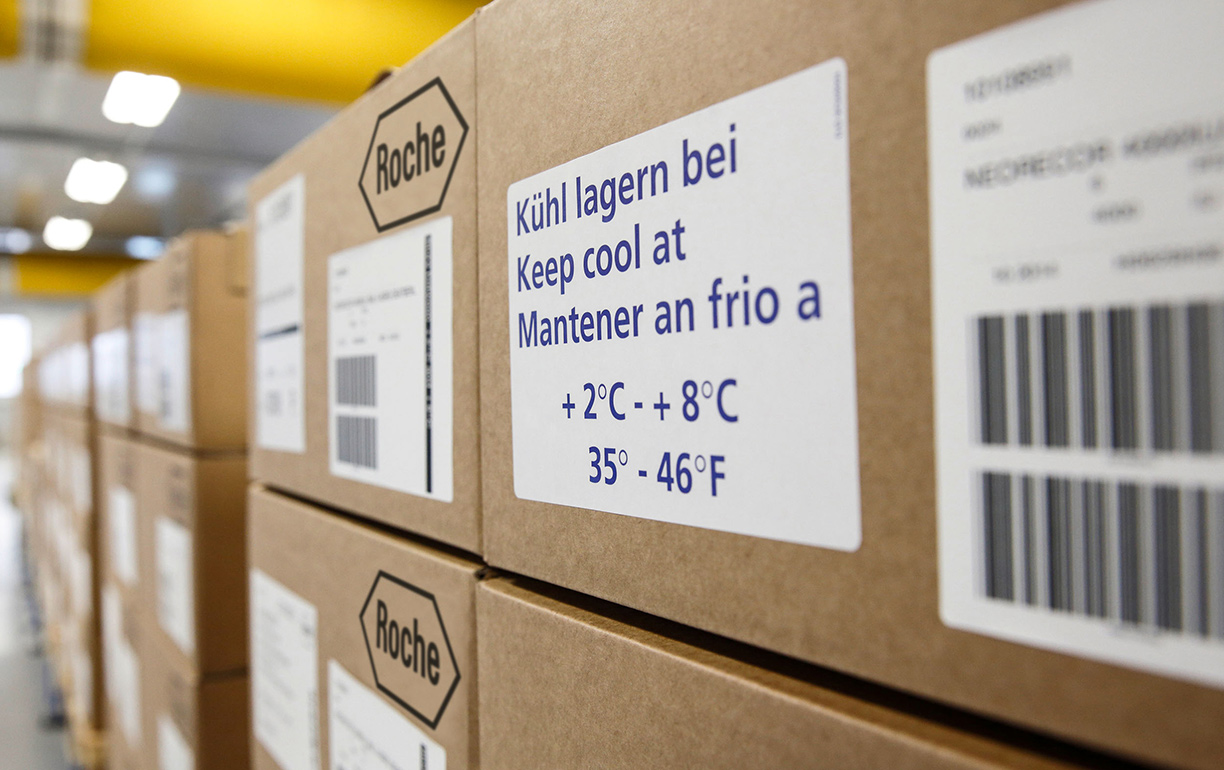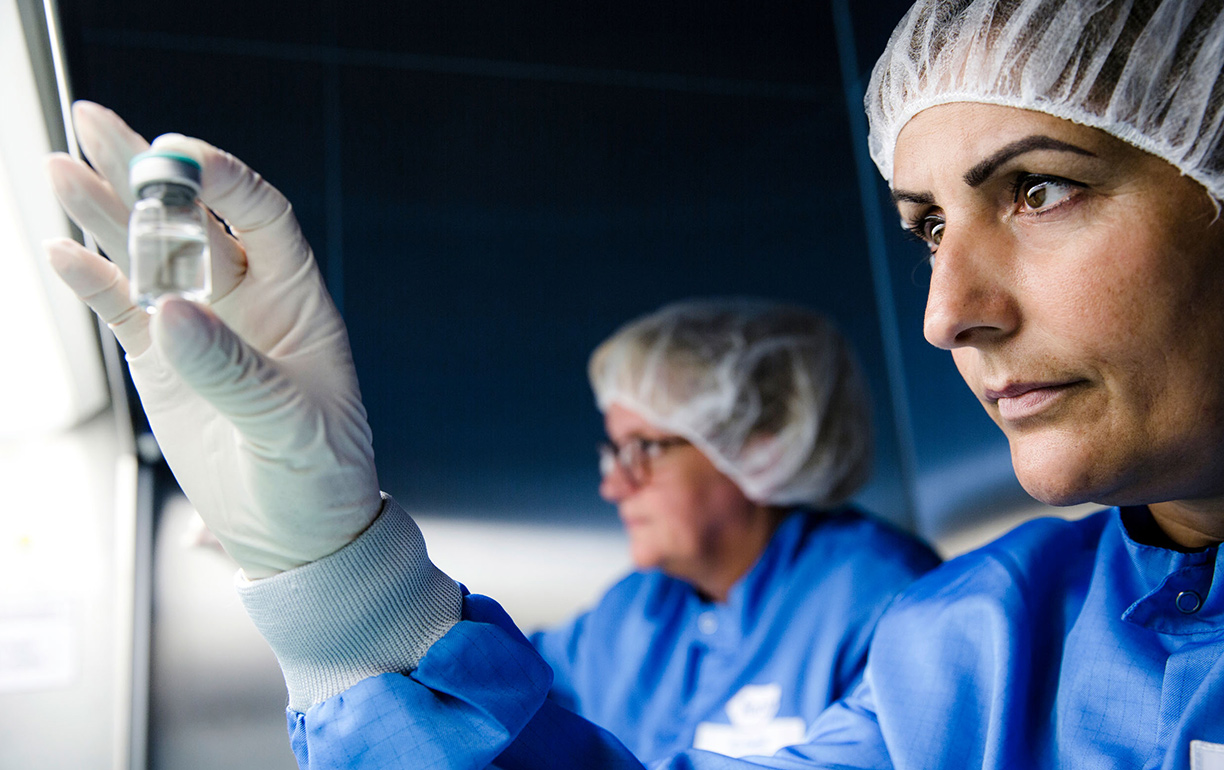
Keeping cool. --
The logistics center of Roche Diagnostics in Mannheim supplies the world with diagnostic solutions designed to detect diseases. The products are temperature-sensitive and subject to strict regulations. The shipper therefore only trusts selected airlines.
|
The shelf storage and retrieval vehicle zooms up from down below. The nimble robot grabs a pallet from the seventh floor and disappears with its load as quickly as it has arrived. Hundreds of different diagnostic products are stored here. The tireless helper in charge of this warehouse always knows exactly which product is waiting where, and what goes where. |
The two fully automated high-bay warehouses of Roche Diagnostics in Mannheim, the third-largest location of the Swiss Roche Group in the world, provides space for 65,000 pallets and 48,000 small containers. The warehouses are divided into 21 aisles, each separated from the next by a solid concrete wall. This allows for accurate temperature control in each individual section. The walls also have a fire protection function. |

Unconditional ability to deliver.
“No matter what the circumstances, we must always be able to deliver,” explains Nourddin Odris. “To minimize risk, each product is distributed across several aisles, so that if there was a fire in one aisle, we would still have every product in stock and would be able to deliver.” Nourddin Odris is Head of Transport Management Global Supply Chain at Roche Diagnostics. He is responsible for ensuring that the global distribution runs smoothly.

Today more and more people in the world have access to medical care. Roche Diagnostics supplies customers in 170 countries. The most important markets are the USA and China, but the major emerging and developing countries also need diagnostic products. The extent of the business is therefore enormous – and it is more than a business, Nourddin Odris points out: “We sell reagents and other diagnostic products that are indispensable in an effort to detect and treat diseases.”
|
As well as the improvements in medical care worldwide, it is also population growth and the fact that people, especially in the western world, are living longer lives that have resulted in steady growth for the business of Roche Diagnostics. The company delivers thousands of tons of diagnostic products across the globe. About a third of this is sent by airfreight. On average this amounts to about one fully loaded Boeing 777 freighter per day. “Airfreight is indispensable in our business,” says Odris. “This is due to its speed of delivery and the option of keeping the temperature constant over the entire transport route, but also because certain markets can only be supplied by air.” Shipments from Mannheim are carried by Lufthansa Cargo from the Frankfurt hub. |
Roche Diagnostics banks on quality: “We do rely on professional expertise on the part of the forwarders and airlines,” says Odris. “Lufthansa Cargo has this expertise, and that is why we have been working closely with them for 20 years now. Because only if the competent handling of our products can be guaranteed throughout the entire transportation process will our temperature-sensitive products reach their destination in optimum quality.” |

Over 95 percent “Cool-Passive”.
More than 95 percent of the shipments dispatched by Roche Diagnostics that are distributed by Lufthansa Cargo through its worldwide network use the “Cool-Passive” product. Only for raw materials and precursors does the Mannheim-based company occasionally also use the “Cool-Active” product. “On the one hand, this comes down to the cost issue,” Odris explains. “On the other, ‘Cool-Active’ is not available at all stations, for both infrastructural and regulatory reasons.” This is why teams of experts with experience in effective packaging and the precise dosing of dry ice have been formed at Roche Diagnostics. “These days a shipment can be kept at a constant temperature for more than five days with dry ice,” according to Odris.

The regulatory requirements for healthcare companies such as Roche are extremely strict: data loggers accompany every shipment, and the logs are checked after every trip. If a temperature fluctuation beyond the acceptable range (which sometimes may only be a few degrees Celsius) is detected, the goods must be destroyed. This ensures that only products of impeccable quality are used for patients.
The complete and seamless documentation process starts at Roche Diagnostics in-house: every step of every single parcel or box – from the high-bay warehouse to order picking to goods dispatch – is scanned using barcodes. Yet there comes a point when Roche’s logistics specialists have to hand over their shipment to forwarders and airlines.
|
“It’s important to us that we work with partners who are able to carefully transport our consignments around the world in the required quality, on time and in full,” says Odris. He therefore welcomes the fact that the airline association IATA and its Center of Excellence for Independent Validators in Pharmaceutical Logistics (CEIV Pharma) has defined a global standard for the transportation and storage of pharmaceutical products. Lufthansa Cargo has been one of the first carriers to meet the strict CEIV regulations since as far back as 2016. Independent experts have audited the airline’s processes used in the products “Cool-Active” and “Cool-Passive”. |
In a separate move, the 8,000-square meter Lufthansa Cargo Cool Center in Frankfurt successfully passed the certification procedure. “We’re interested in a long-term partnership, and the CEIV certificate tells me that we can rely on Lufthansa Cargo,” Odris explains. “We welcome the fact that a growing number of stations in Lufthansa Cargo’s network now meet the strict requirements of the pharmaceuticals industry.” |

For Roche Diagnostics, airfreight is important not only for the transportation of reagents and test strips for detecting diseases: to use them, hospitals, doctor’s surgeries and laboratories additionally need the analytic equipment that is also distributed by the company. These can be small, compact hand-held units or units the size of several washing machines that can fill entire halls. Only once the equipment has been installed on site can the actual work of carrying out the diagnostic testings begin, with chemically coated test strips and sensitive reagents from Roche Diagnostics being used to detect diseases in human blood, urine or tissue.

A sugar cube in Lake Zurich.
Among other goods, products in the company’s Elecsys system are shipped from Mannheim all over the world. These analytical systems are an immense success story for Roche. Well over a 100 different test parameters available within the Elecsys family are used to detect HIV, hepatitis or the Zika virus, for example.
Elecsys can also be used to diagnose thyroid disorders. The technology is extremely sensitive: it can easily detect a sugar cube dissolved in more than three cubic kilometers of water, roughly the volume of water contained in Lake Zurich. Statistics show that one in four people will do this kind of test once a year – and the trend is rising. There is no danger of Odris and his team running out of work anytime soon.
Partner for temperature-sensitive freight.
Partner for temperature-sensitive freight.
|
The pharmaceutical industry’s requirements for airfreight are growing – in terms of volume, new regulatory requirements and longer and more complex transport chains. “The Cool Master Plan is our response to these requirements,” says Christian Fleischhauer, project manager for the Cool Master Plan at Lufthansa Cargo. “The plan covers the expansion of our network of CEIV Pharma-certified stations, improved temperature control across the entire transport chain, and transparency for the customer thanks to digitalization,” adds his colleague Chris Dehio, Senior Product and Quality Manager Cool.
Certification:with the “CEIV Pharma” certificate, the airline association IATA has set a worldwide industry standard for transportation of pharmaceuticals by air. As long ago as October 2016, Lufthansa Cargo was awarded this seal both for their Cool Center in Frankfurt and for their worldwide processes. In order to acquire additional certification, Lufthansa Cargo is investing in upgrades to their temperature control infrastructure. “Under the Cool Master Plan, this investment will grow into the double-digit millions,” says Christian Fleischhauer. The plan also covers the Cool Center at the Munich hub, planning for which takes account of the requirements for CEIV pharmaceutical certification. Cooling infrastructure is also being upgraded at stations in Chicago, Atlanta, Washington and Mexico. |
Temperature control:to avoid temperature fluctuations, Lufthansa Cargo puts great store into smooth interaction between handling, warehousing and transportation. These processes are continually upgraded in accordance with CEIV Pharma directives. As temperatures out on the apron can reach extremes, the processes at Lufthansa Cargo are designed to minimize the time spent there. Additional protection is provided by a reflective foil used for all “CoolPassive” consignments, and also with high-performance packaging solutions such as the va-Q-tainers, which can be booked via Lufthansa Cargo. Temperature-sensitive hazardous goods can also be transported in strict compliance with the IATA Dangerous Goods Regulations. Even more efficient is the “Cool-Active” product, which employs heating and cooling containers to keep the internal temperature constant regardless of the outside temperature – from the point of origin through all stages of air transportation to the destination.Digitalization:Lufthansa Cargo banks on transparency through digitalization. The IDB database provides detailed information about all Lufthansa Cargo stations even before a booking is made. The IT tool SPoT (Special Product operation Tool) is used to monitor processes, especially those for “Cool” products. DGD.online also contributes toward greater transparency in connection with temperature-sensitive hazardous goods.
|
